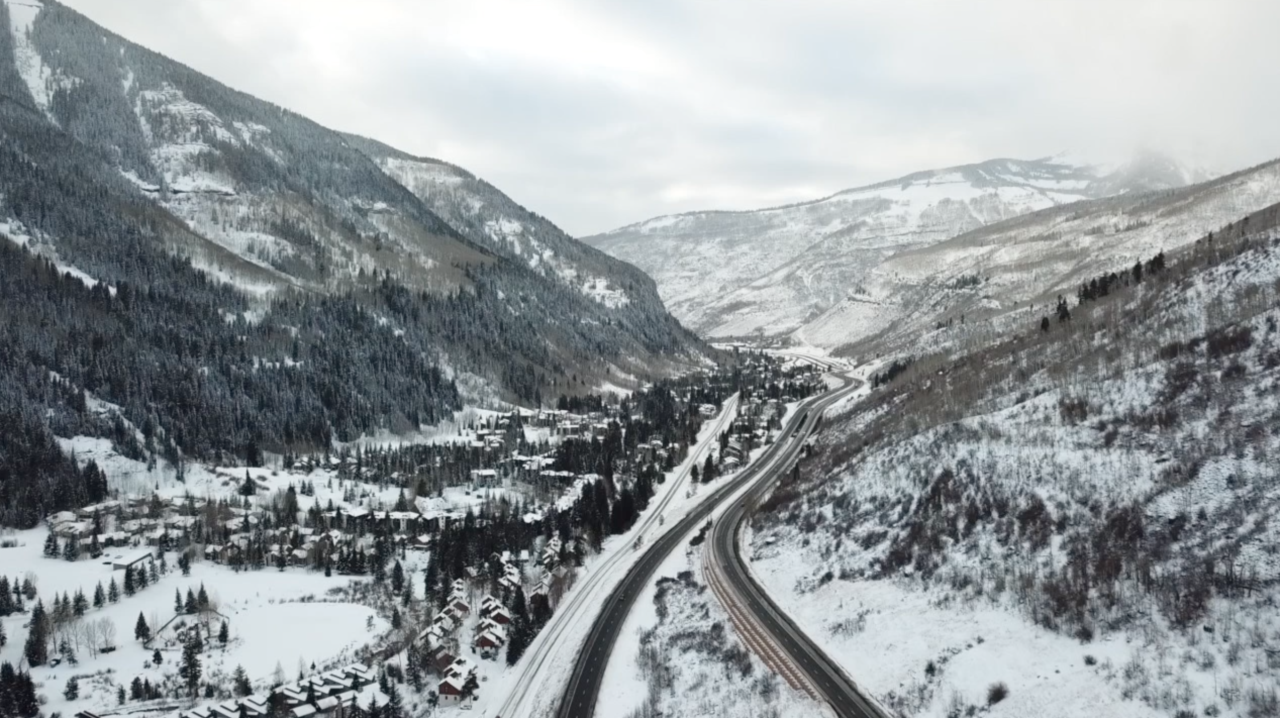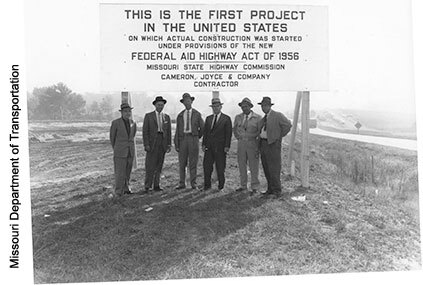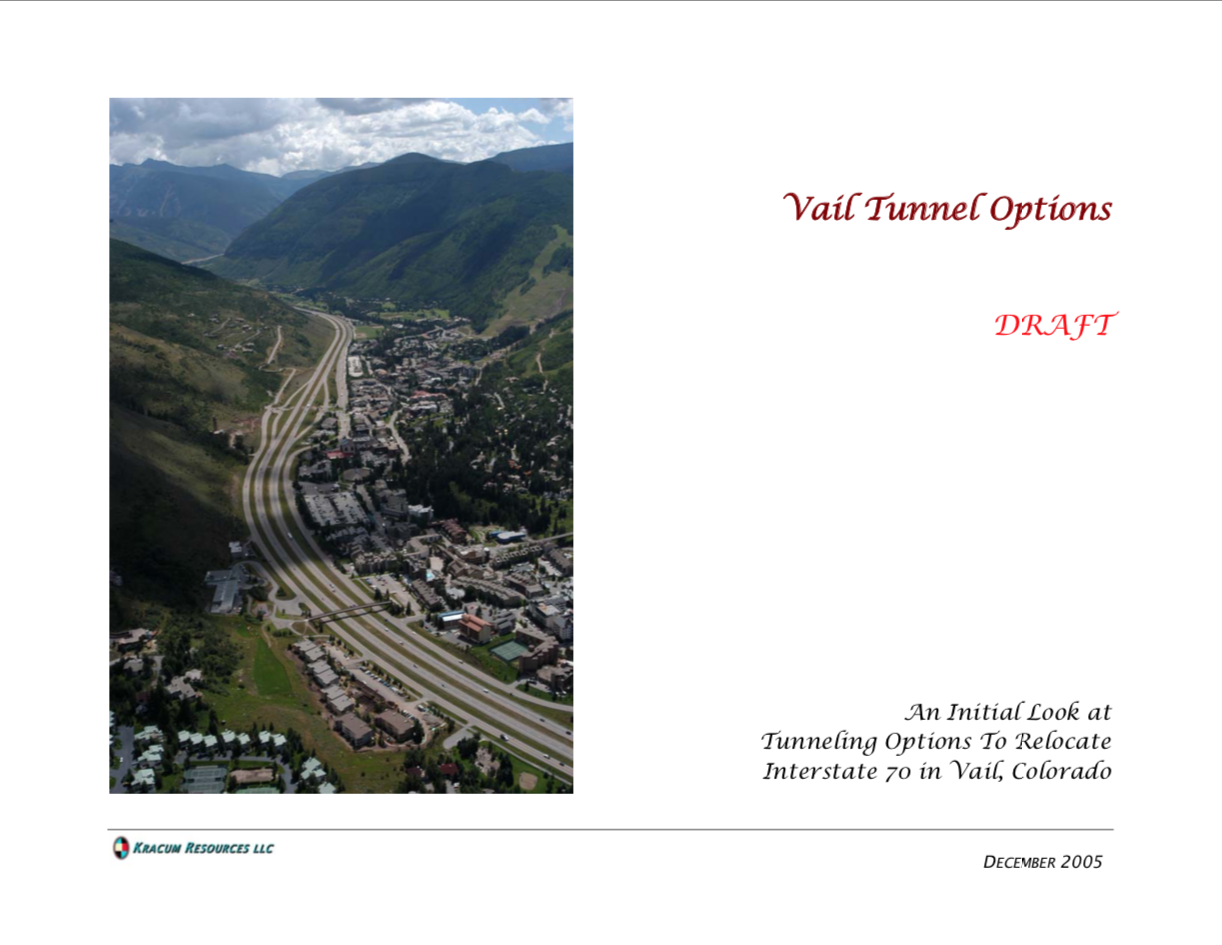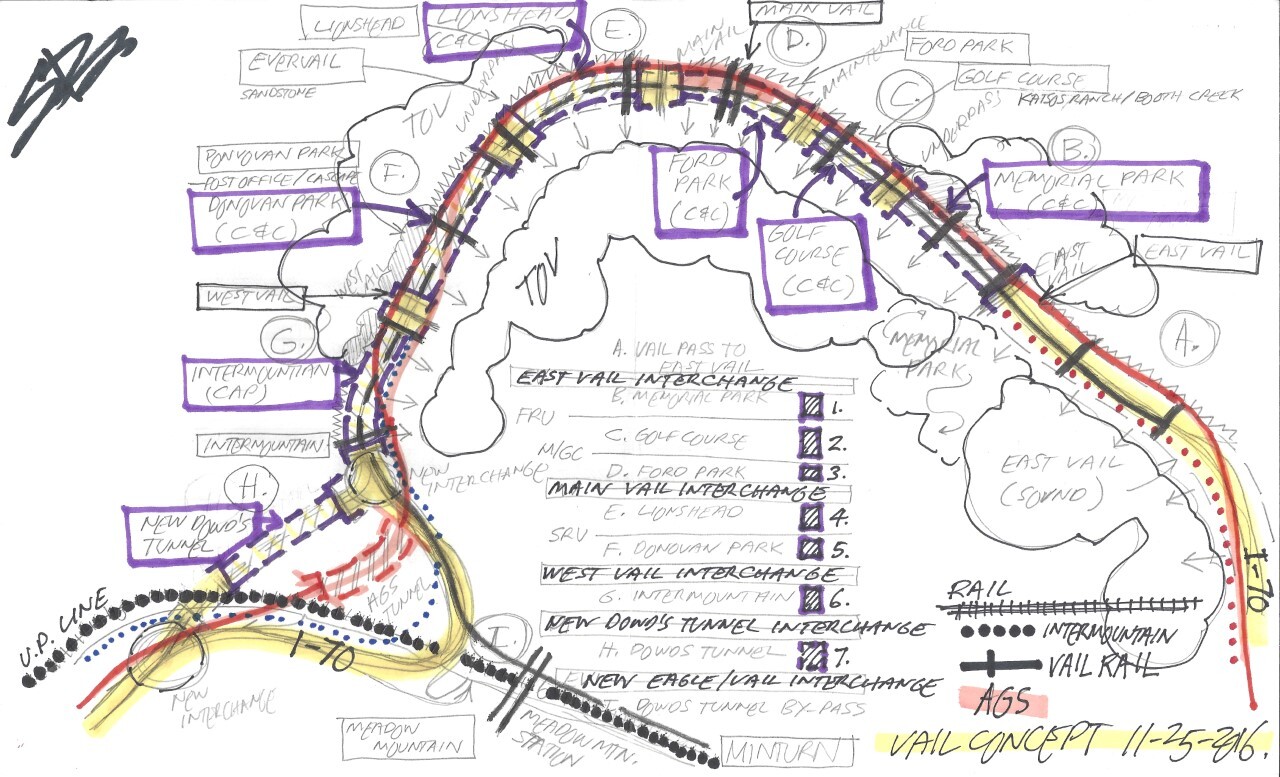VAIL, Colo. — As long-dead plans for infrastructure go, the 53-page, single-spaced document archived on the Vail town website makes for an interesting read.
But first, a warning — this might require a little imagination.
The document, authored in 2005 by the Colorado engineering firm Kracum Resources, outlines a fascinating, if not financially feasible, vision: A 9.3-mile tunnel through the heart of Vail Mountain, redirecting Interstate 70 from its existing path through the bustling Colorado ski community.
In a world where such a tunnel exists, I-70 — long a source of frustration for some locals, from highway noise to how it splits Vail in two parts, north and south — would be out of sight and sound, buried beneath Vail's sprawling ski area.
Drivers would either exit into Vail, or they'd bypass the town, coasting through the longest road tunnel in North America.
But the lengthy tunnel — and the other tunnels outlined in the Kracum document — never happened, grounded before the project ever began. That's not to say there was much of a chance they would happen, and even calling it a "plan" might be generous.
An I-70 tunnel of that magnitude, despite the curiosity it might have generated, would have been burdened by a steep cost and the prospect of years and years of construction.
But as ski season ramps up, and thousands of Coloradans and visitors flock to the mountains, it is curious to re-imagine what a drive to, and through, Vail would look like, and how driving nearly 10 miles through a tunnel — through a mountain — would feel.
"The damned mountain couldn't read"
You get in the car in Denver and drive west on I-70, the foothills coming up, the bowl-faced peak of Mount Evans in the distance, the highway rising past the red rocks of Morrison.
At Genesee Park, the roadway opens to the Rockies, a vista of snow-capped peaks. The highway bends through Evergreen and finds Clear Creek, hugging the rapids through Idaho Springs and Empire and Georgetown.
You see the first ski lift at Loveland Pass, where the slopes fall across the Continental Divide and the snow falls by the foot. For the next 1.7 miles — 8,941 feet, to be exact — you glide through an engineering marvel.
The Eisenhower Memorial Tunnel, the highest road tunnel in the world at an elevation of 11,155 feet, took five years to build, as workers toiled at altitude, stalled by a stubborn mass of Earth. One contractor on the project quit.
"We were going by the book," a highway engineer said, "but the damned mountain couldn't read."

The tunnel spits I-70 into Summit County, and you dip through Silverthorne and Frisco. Past Copper Mountain, I-70 shifts back north, up Vail Pass. The pass, and then the town, were named after Charles Vail, who designed that section of roadway through the mountains in the 1930s.
I-70 descends into Vail and passes over Timber Creek, a few miles before town.
This is where that imagination might come in handy.
Instead of continuing into Vail, you decide to take the bypass. You don't exit; you stay on I-70, and the highway juts west, into a tunnel.
Inside, there is no end in sight, because the light at the end of the tunnel is 9.35 miles away — 49,400 feet, to be exact.
Of course, there are plenty of lights in the tunnel — it runs up an electric bill of about $10 million per year. You cruise along, deep below the snowpack and the pine forests and the ski lifts and the sun-soaked slopes.
You can breathe just fine, but only at a cost; the tunnel's ventilation system was just one costly complexity added to the multi-billion-dollar project.
When the highway hits daylight again, you are west of Vail, as if the town was never there.
"The bane of Vail's future"
Sound crazy enough?
That a tunnel through Vail Mountain was ever conceived might say more about I-70's role in Vail as it does about any ambition to actually build one.
No one denies the highway's influence on the community. Without it, Vail surely would not have flourished the way it has. Even with the nearby Eagle County Airport, the interstate makes Vail a two-hour drive from Denver (traffic permitting), a manageable trip for locals and visitors alike.
But I-70 essentially splits the town in two sides, north and south, a busy highway through the heart of an upscale ski community. Traffic noise has been a chief complaint surrounding the highway, along with environmental concerns, such as pollution and wildlife crossings, though crossings have been built in recent years.

And while I-70 discussions had sparked off and on through the years, the complaints seemed to hit an inflection point in the early 2000s, as traffic volume increased and the constant hum of semi-trucks barreling down Vail Pass annoyed residents. Part of the uptick in truck traffic came after the final link of I-70 was completed through Glenwood Canyon, west of Vail.
In 2000, the town of Vail commissioned a noise study and concluded that about 25% of homes in Vail exceeded 66 decibels, the criteria set by the Colorado Department of Transportation for noise abatement.
"There's nothing this community would enjoy more than having I-70 disappear from our sight and our ears," Kaye Ferry, then director of the Vail Chamber & Business Association, told the Rocky Mountain News in 2006. "And ears are the big thing."
The News' story outlined the tunnel idea and how such a costly behemoth of a project ever became a discussion in Vail.
When a sinkhole shut down I-70 for a week in 2003, residents noticed something odd coming from the highway corridor through town: Peace and quiet.
They called CDOT, and interest in a tunnel gradually piqued curiosity.
As the News' Deborah Frazier reported, the top proponent of the tunnel was Jim Lamont, executive director of the Vail Village Homeowners Association.
Lamont "dreams big — $6 billion big," Frazier wrote. "To eliminate traffic noise from Interstate 70 in the resort community, he envisions a privately financed tunnel under Vail Mountain and burying the interstate where it passes through town."
Lamont, at the time, acknowledged the steep cost of a privately-funded project. But he suggested it might just be possible in Vail.
"People in Vail speak in billions," he told the newspaper.
Lamont's argument in 2005 was that I-70 was "the bane of Vail's future."
"Currently, the highway is the primary cause of chronic noise, visual and water pollution," Lamont wrote in a 2005 memo to board members of his homeowners' association. "It dominates the landscape and cleaves the community in half. The desirability of being outdoors in Vail will deteriorate; by 2025 daily traffic is expected to almost double and noise levels will increase by 50% or more."
(Lamont's traffic projection wasn't far off: I-70 through Vail averaged about 23,400 vehicles per day, according to the News story in 2006. In 2019, I-70 traffic through Vail peaked in West Vail at 40,000 vehicles per day.)
But tunneling the highway through Vail wasn't a CDOT priority.
"We would not put any money into covering I-70 through Vail," CDOT's Ed Fink told the News. "It's not impossible, but it's akin to climbing Mount Everest."
The Town of Vail listened. But the project failed to catch momentum.
“It’s important to have people like Jim Lamont, who is a futurist of sorts, who think outside the box,” Vail town manager Stan Zemler told the News in 2006. “There is a lot of concern about the noise. It always comes up on resident surveys. But we’re not going to make it go away. It’s a reality of I-70."

Why an "audacious" idea fizzled
Fifteen years later, Lamont acknowledged the obvious: A lengthy tunnel project through Vail Mountain would likely have not been financially feasible.
But Lamont, who still serves as executive director of the homeowners’ association, expressed frustration over the unwillingness of some in Vail to not consider the tunnel.
“Everybody had an excuse to do nothing, except live with the intrusiveness of highway noise,” Lamont said. “Vail goes through these mindsets at times, where, again, everybody’s ego gets in the way of listening.”
Lamont pointed to Europe, where lengthy mountain road tunnels are common. The longest road tunnel in the world, Laerdal, is in Norway and measures 15.2 miles. The St. Gotthard tunnel in Switzerland runs 10.5 miles.
Shorter tunnels — but all longer than any in North America — connect the Alps, and a growing number of lengthy road tunnels are in China.
The longest road tunnel in North America is the Anton Anderson Memorial Tunnel in Alaska, at 2.5 miles.
Lamont said interest in a Vail tunnel, among locals, “took off like a rocket.”
But the idea ultimately faded, the $5 billion pricetag, if not higher, being the main detriment.
Greg Moffet, a Vail councilmember from 2003-2017, supported exploring I-70 projects, even if the money seemed out of reach.
“All sorts of things get funding in Washington, D.C.,” Moffet told the News. “At the bottom of it all, if you don’t ask, you don’t get.”

Eventually even I-70’s detractors figured it was just something the town had to live with, Moffet said.
“Most of us have a love-hate relationship with [I-70],” Moffett said. “But it’s a relationship. There’s a lot of other ski towns that like to take shots at Vail for being on I-70. And those shots
are just fine — until they need to get somewhere.”
Zemler, the Vail town manager in 2005, said he “handled it very delicately” when the tunnel idea got floated.
“To me, it was sort of a ‘why?’ question,” Zemler recalled last summer. “Why would someone spend that insane amount of money so Vail doesn’t have highway noise?"
Moffet acknowledged the elephant in the room of a Vail tunnel: “Optically it would be spending highway money to make millionaires and billionaires to not have to listen to highway noise.”
“If you wanted to be the congressman to propose that,” Moffett said, “good luck with that.”
Zemler worked with CDOT to install noise-reducing pavement, and Moffett said the pavement has helped with the noise.
As town manager, “I was required to be pragmatic,” Zemler said.
Lamont’s frustration, today, is Colorado’s growth and his belief that leaders, in general, aren’t willing to explore solutions or invest in infrastructure, whether it’s a costly undertaking or not.
“There has to be a realization that growth at any cost, on the Front Range, is not acceptable throughout the rest of the state of Colorado,” Lamont said.
Lamont pointed to the Interstate Highway System, which cost billions upon billions and took decades to complete. President Dwight Eisenhower, who set the system into motion, understood the advantage Germany had in its autobahn superhighways.
“That was audacious but it was necessary at the time,” Lamont said. “We have to make some decisions here that – is our democracy worth the investment? Otherwise, our competition will be in the third world, not first world.”

Possible, but no guarantees
That’s the word: Audacious.
A 9.3-mile interstate tunnel through a mountain — on a continent where the next-longest road tunnel would be one-quarter the length — would be expensive and time-consuming and, above all else, audacious.
“Just this one project would be seven or eight times what we spend statewide on projects a year,” said Steve Harrelson, Colorado Department of Transportation’s chief engineer.
Harrelson cited CDOT’s annual budget of about $900 million and estimated a Vail mountain tunnel would cost in the range of $6-7 billion.
And Harrelson made it clear: A Vail tunnel was not — and is not — a priority for CDOT.
But the state’s top road engineer, a self-professed “tunnel geek,” admitted the idea, from an engineering standpoint, is fascinating.
Aside from the initial pricetag, Harrelson pointed to two hurdles for a tunnel of that length.
The actual tunneling process would require a tunnel boring machine at least 60 feet in diameter, and one of that size does not exist. Instead, crews would likely have to drill and blast their way through the mountain, similar to how the Eisenhower Tunnel was built.
While the Eisenhower Tunnel was a much shorter project, crews found trouble in the Loveland fault zone. They’d tunnel through loose sand and gravel and boulders, and the mountain would cave in.
Vail Mountain would be more stable. But over nearly 10 miles, there are no guarantees.
“Once you get in there, it's kind of like Forrest Gump — it's like a box of chocolates, you never know quite what you get until you're in there,” Harrelson said. “And, you know, there's a lot of risk with that with that geology and it's hard to predict until you open it up.”
And in the scenario where a tunnel is completed, the operating and maintenance costs would be an ongoing burden.
Eisenhower Tunnel, for example, can run up an electric bill of more than $100,000 per month, Harrelson said, depending on how much crews have to run the tunnel’s ventilation fans. Eisenhower is also staffed 24/7 for maintenance. Even today, trucks carrying hazardous materials are not allowed to pass through the tunnel, unless Loveland Pass is closed, though CDOT is studying HAZMAT options.
“As you drive through it, you don’t realize it,” Harrelson said, “but there’s a city up there that maintains that place, even when it’s not snowing. And when it’s snowing, it’s all hands on deck.”

Several options for a Vail tunnel
Still, the Kracum Resources study concluded that tunneling was possible, not only through Vail Mountain but also north of I-70 and near the Vail Golf Course.
The study outlined five tunnel options:
• Through Vail Mountain, from Timber Creek to Dowd Junction: 8.6 miles
• North of I-70, from the Gore Creek Campground to Vail Public Works: 5.6 miles; and a second segment, from Public Works to Dowd Junction: 6.4 miles.
• West of Bighorn to near the golf course: 4.2 miles; and then connecting to the tunnel from Public Works to Dowd Junction: 6.4 miles.
• Cut-and-cover, essentially burying I-70 along its existing path through Vail for 8 miles.
• Through Vail Mountain, from Timber Creek to Eagle-Vail: 9.4 miles.

The Kracum report outlined, in detail, the challenges and requirements of each tunnel, all of which would have required systems for power supply, ventilation, fire safety, lighting, water supply, surveillance, emergency vehicles and service buildings.
Ventilation would have been “a challenge, but is not expected to be a fatal flaw in the design,” the report said.
The other challenge of tunneling: Loads and loads of excess dirt.
Each Vail tunnel option would have required millions and millions of cubic yards of dirt to be hauled away.
For the lengthiest option, the Kracum study estimated 5.9 million cubic yards, or about 492,000 truckloads.
Hauling away all that dirt would have required about 350-375 truck trips per day, for four years, the study estimated.
The Kracum study also outlined the likely schedule for a project of such magnitude.
Before a shovel even hits the ground, officials would have to spend about five years on feasibility studies, environmental impact statements and preliminary designs.
The effort would require coordination from Vail town hall to the Federal Highway Administration to CDOT and the U.S. Forest Service.
Feel buried yet?
“It never got to the point where it’s [people] for or against” an I-70 project, said Moffett, the former Vail councilmember. “Because we were too busy figuring out how we can make something that crazy work. And I think we concluded that we couldn’t.”
Steering away from a "tunnel mentality"
Doing something about I-70 never fully went away.
In 2017, CDOT opened the Sandstone Underpass along I-70 through Vail. The underpass was designed to improve connectivity and safety for pedestrians and cyclists. The project was part of Vail’s transportation master plan in 1992.
The closest thing to the 2005 tunnel ideas came a few years ago, when Eagle architect Sig Bjornson presented his plan for a “cover-and-cap” of I-70 through Vail.
Bjornson, a 26-year resident of Eagle County, designs buildings but always had an interest in I-70. For years he viewed the highway as an “ongoing scar through town,” despite its benefit to Vail’s growth.
Bjornson said Vail was modeled “as this kind of Bavarian, European ski town.”
“The only problem is we have this 400-foot swath that cuts right through it, which isn’t very European,” Bjornson said.
After the 2005 discussions over an I-70 tunnel, Bjornson put pencil to paper and scribbled up some designs.
Bjornson’s proposal, which he presented to the town in 2016, involved bringing the I-70 lanes closer together, burying the roadway through Vail and stacking the frontage roads on top.
The plan would create a series of smaller I-70 tunnels through Vail, avoiding the need for more expensive ventilation systems and creating more real estate space along the frontage roads above the highway.
Bjornson’s plan, he concluded, would reduce the noise from I-70 traffic, cost less than longer tunnel options and connect north and south Vail.
Bjornson argued his plan would have steered away from a “tunnel mentality,” not burying I-70 as much as building over the top of it.
Bjornson’s idea garnered some interest but no action was taken. Like Lamont, he expressed frustration, feeling as if some locals were dismissive about discussing an I-70 option.
“These are people who have a toilet sitting in the middle of their master bedroom,” Bjornson said, “and they think that’s fine. They’ve had that toilet sitting there for 30 years.”
Moffet, the former councilmember, is more optimistic that a future with autonomous vehicles will help ease congestion along I-70. Over the years, Moffet said, the money just wasn’t going to be there for a massive highway overhaul — not that there’s anything wrong with talking about it.
“One of the fun things about Vail is there’s a lot of incredibly clever, incredibly smart, creative people,” Moffet said. “Maybe someday, when we come across a rich uncle, we’ll dig a hole. Who knows?”



